#Cultic game
Explore tagged Tumblr posts
Text



E1M7 - In their sights.
Sniper enemies are cool I guess. Totally normal about them.
91 notes
·
View notes
Text
Round 1

14 notes
·
View notes
Text
Live now!
It's TNT tossing time!
Tonight Hime-Sama finishes up both the fan made expansion for Blood, Death Wish, as well as the indie shooter Cultic!
-RRA Social Media Team
twitch_live
#vtuber#envtuber#indie vtuber#retro gaming#retro games#indie games#boomer shooters#boomer shooter#fps#blood#cultic
3 notes
·
View notes
Text
i gotta learn how to gif stuff, cuz i found a game about a family living with the aftermath of its mysterious patriarch's death, and instead of the player character being like, an heir or a detective, you are the dead man's over-fed HOUSE CAT and you guys gotta see the cute lil cat animations
#i am on chapter two and so far its a lovely experience#Cats and the Other Lives#cultic games#its friday night baybee we be niche posting
2 notes
·
View notes
Text

i recently bought and played through all of cultic and absolutely loved it! i decided to make a small bit of art of it! if you’re looking for a grimy, grounded, supernatural boomer shooter, then i highly recommend cultic! :D
#my art#sketchbook#inked sketch#cultic#fps shooter#boomer shooter#indie games#game fanart#cultic fanart
9 notes
·
View notes
Text
One Man Investigative Army - Cultic
Over the past two weeks I have played two different Doom-esq games and I am here to talk about them. Cultic is this week and its really good. People go missing so you need to make cultists meets their new bullet friends #Cultic #Blog #Indiegame

View On WordPress
3 notes
·
View notes
Text
play pizza tower, play ultrakill, play everhood, play omori, play fuckin anything really, please please please always support and check out the little guys and the smaller ideas. Deep Rock, Risk of Rain, Baba is You, there are so many out there
hell not only indie games but mods for games too, the medium is never dying, and there are so many talented people out there with visions and all sorts of shit. Experience the wonder of hat in time or the brutal fast paced carnage of turbo overkill, the retro revivals like shovel knight. The new genre defining ones like vampire survivors
i fucking love indie games, the visions of auteurs artists creatives and small studios will always bring forth something wonderful, keep them alive and hold them dear
Tell me you don't play indie games without telling me you don't play indie games.

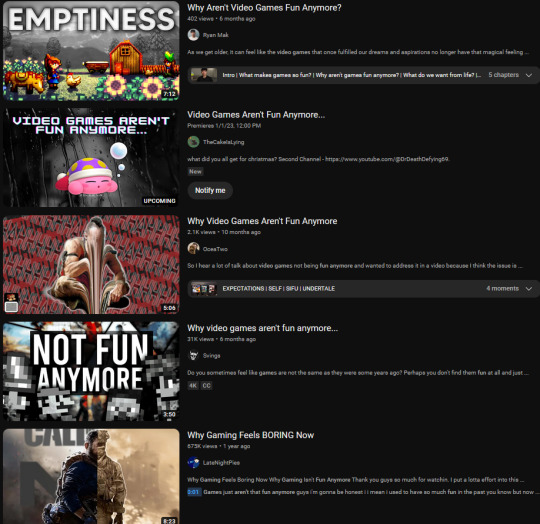


#put game reccomendations in like tags or something idk#ultrakill#turbo overkill#deep rock galactic#undertale#deltarune#brutal orchestra#shovel knight#omori#risk of rain#30XX#roboquest#cultic#dusk#forgive me father#dwarf fortress#everhood#furi#hades#have a nice death#tunic#the video game not the piece of apparel#wobbledogs#ghost song#blasphemous#haiku the robot#moonscars#dead estate#creeper world#rainworld
1K notes
·
View notes
Text
thank you ALL for watching tonight's stream.
0 notes
Text
youtube
Cults are scary.
1 note
·
View note
Video
youtube
CULTIC: Chapter One
Cultic is fantastic. The guns feel great, with all of them feeling like worthwhile additions to your arsenal. The level design was top notch and, despite the general zone theming being similar, it managed to have each level have a completely different texture. Most shooters tend to get tedious in later areas, with them trying to ramp up the difficulty by putting bullet sponges everywhere. Cultic didn't do that.
The only miss for me was the chapel level, but ultimately that wasn't a bad level, just not as enjoyable as the other ones.
I am very happy I decided to give Cultic another shot. It hit with me in a great way. I'm looking forward to whenever chapter two drops.
Playlist: https://www.youtube.com/playlist?list=PLMOeTsMoezKaMSZOaL3BuHkuhyexAB5_Q
0 notes
Text
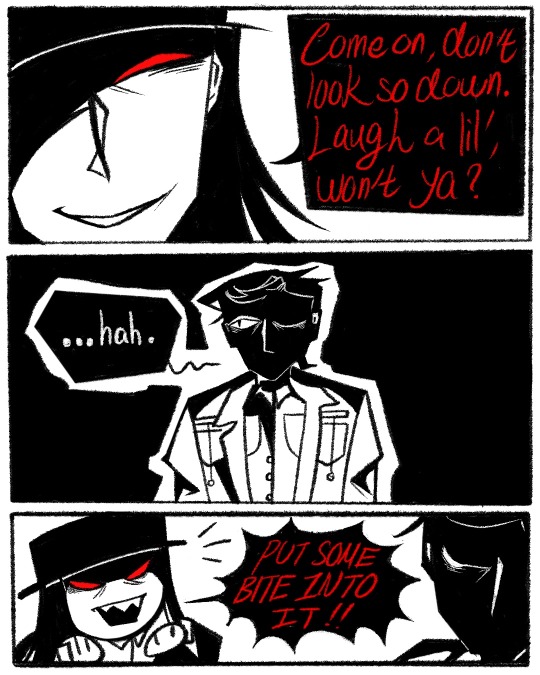
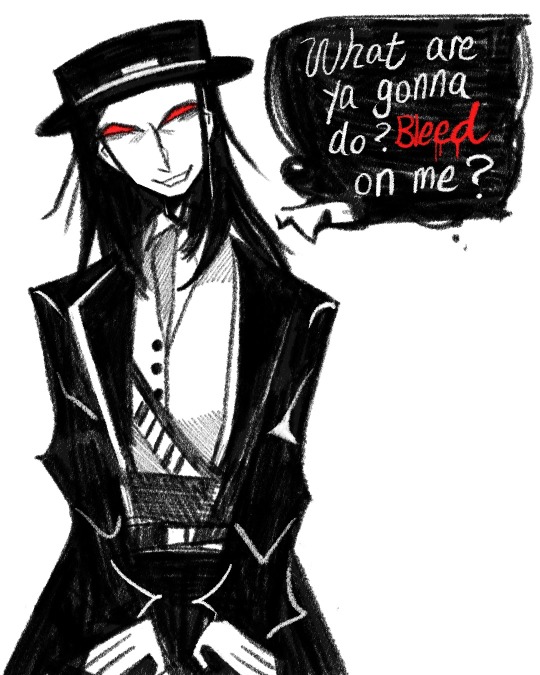
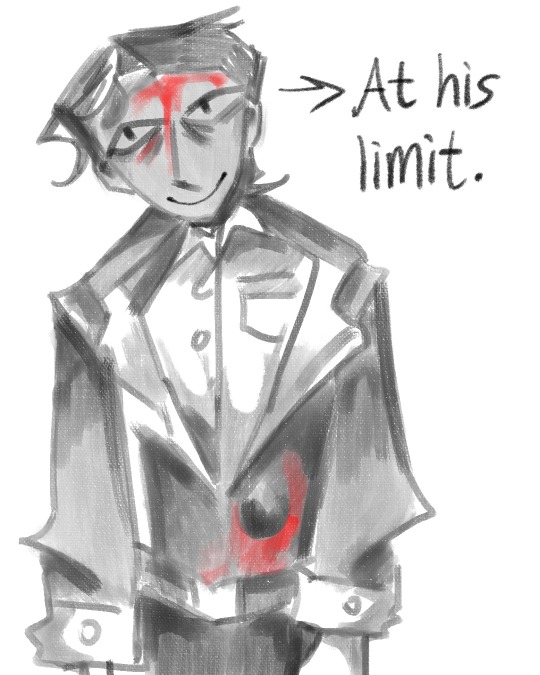

CULTIC x Blood scribble posting.
A sadistic undead gunslinger probably wouldn’t mix well with a silent but also undead detective. Won’t stop Caleb from trying to teach him how to laugh maniacally still, though.
90 notes
·
View notes
Text
In defense of retellings & reimaginings
I'm not going to respond to the post that sparked this, because honestly, I don't really feel like getting in an argument, and because it's only vaguely even about the particular story that the other post discussed. The post in question objected to retellings of the Rape of Persephone which changed important elements of the story -- specifically, Persephone's level of agency, whether she was kidnapped, whether she ate seeds out of hunger, and so on. It is permissible, according to this thesis, to 'fill in empty spaces,' but not to change story elements, because 'those were important to the original tellers.' (These are acknowledged paraphrases, and I will launch you into the sun if you nitpick this paragraph.)
I understand why to the person writing that, that perspective is important, and why they -- especially as a self-described devotee of Persephone -- feel like they should proscribe boundaries around the myth. It's a perfectly valid perspective to use when sorting -- for example -- which things you choose to read. If you choose not to read anything which changes the elements which you feel are important, I applaud you.
However, the idea that one should only 'color in missing pieces,' especially when dealing with stories as old, multi-sourced, and fractional as ancient myths, and doing so with the argument that you shouldn't change things because those base elements were important to the people who originally crafted the stories, misses -- in my opinion -- the fundamental reason we tell stories and create myths in the first place.
Forgive me as I get super fucking nerdy about this. I've spent the last several years of my life wrestling with the concept of myths as storytelling devices, universality of myths, and why myths are even important at all as part of writing on something like a dozen books (a bunch of which aren't out yet) for a game centered around mythology. A lot of the stuff I've written has had to wrestle with exactly this concept -- that there is a Sacred Canon which cannot be disrupted, and that any disregard of [specific story elements] is an inexcusable betrayal.
Myths are stories we tell ourselves to understand who we are and what's important to us as individuals, as social groups, and as a society. The elements we utilize or change, those things we choose to include and exclude when telling and retelling a story, tell us what's important to us.
I could sit down and argue over the specific details which change over the -- at minimum -- 1700 years where Persephone/Kore/Proserpina was actively worshiped in Greek and Roman mystery cults, but I actually don't think those variations in specific are very important. What I think is important, however, is both the duration of her cults -- at minimum from 1500 BCE to 200CE -- and the concept that myths are stories we tell ourselves to understand who we are and what's important to us.
The idea that there was one, or even a small handful, of things that were most important to even a large swath of the people who 'originally' told the store of the Rape of Persephone or any other 'foundational' myth of what is broadly considered 'Western Culture,' when those myths were told and retold in active cultic worship for 1700 years... that seems kind of absurd to me on its face. Do we have the same broad cultural values as the original tellers of Beowulf, which is only (heh) between 1k-1.3k years old? How different are our marital traditions, our family traditions, and even our language? We can, at best, make broad statements, and of inclusive necessity, those statements must be broad enough as to lose incredible amounts of specificity. In order to make definitive, specific statements, we must leave out large swaths of the people to whom this story, or any like it, was important.
To move away from the specific story brought up by the poster whose words spun this off, because it really isn't about that story in particular, let's use The Matter of Britain/Arthuriana as our framing for the rest of this discussion. If you ask a random nerd on Tumblr, they'd probably cite a handful of story elements as essential -- though of course which ones they find most essential undoubtedly vary from nerd to nerd -- from the concept that Camelot Always Falls to Gawain and the Green Knight, Percival and the grail, Lancelot and Guinevere...
... but Lancelot/Guinevere and Percival are from Chrétien de Troyes in the 12th century, some ~500 years after Taliesin's first verses. Lancelot doesn't appear as a main character at all before de Troyes, and we can only potentially link him to characters from an 11th century story (Culhwch and Olwen) for which we don't have any extant manuscripts before the 15th century. Gawain's various roles in his numerous appearances are... conflicting characterizations at best.
The point here is not just that 'the things you think are essential parts of the story are not necessarily original,' or that 'there are a lot of different versions of this story over the centuries,' but also 'what you think of as essential is going to come back to that first thesis statement above.' What you find important about The Matter of Britain, and which story elements you think can be altered, filed off or filled in, will depend on what that story needs to tell you about yourself and what's important to you.
Does creating a new incarnation of Arthur in which she is a diasporic lesbian in outer space ruin a story originally about Welsh national identity and chivalric love? Does that disrespect the original stories? How about if Arthur is a 13th century Italian Jew? Does it disrespect the original stories if the author draws deliberate parallels between the seduction of Igerne and the story of David and Bathsheba?
Well. That depends on what's important to you.
Insisting that the core elements of a myth -- whichever elements you believe those to be -- must remain static essentially means 'I want this myth to stagnate and die.' Maybe it's because I am Jewish, and we constantly re-evaluate every word in Torah, over and over again, every single year, or maybe it's because I spend way, way too much time thinking about what's valuable in stories specifically because I write words about these concepts for money, but I don't find these arguments compelling at all, especially not when it comes to core, 'mainstream' mythologies. These are tools in the common toolbox, and everybody has access to them.
More important to me than the idea that these core elements of any given story must remain constant is, to paraphrase Dolly Parton, that a story knows what it is and does it on purpose. Should authors present retellings or reimaginings of the Rape of Persephone or The Matter of Britain which significantly alter historically-known story elements as 'uncovered' myths or present them as 'the real and original' story? Absolutely not. If someone handed me a book in which the new Grail was a limited edition Macklemore Taco Bell Baja Blast cup and told me this comes directly from recently-discovered 6th century writings of Taliesin, I would bonk them on the head with my hardcover The Once & Future King. Of course that's not the case, right?
But the concept of canon, historically, in these foundational myths has not been anything like our concept of canon today. Canon should function like a properly-fitted corset, in that it should support, not constrict, the breath in the story's lungs. If it does otherwise, authors should feel free to discard it in part or in whole.
Concepts of familial duty and the obligation of marriage don't necessarily resonate with modern audiences the way that the concept of self-determination, subversion of unreasonable and unjustified authority, and consent do. That is not what we, as a general society, value now. If the latter values are the values important to the author -- the story that the author needs to tell in order to express who they are individually and culturally and what values are important to them* -- then of course they should retell the story with those changed values. That is the point of myths, and always has been.
Common threads remain -- many of us move away from family support regardless of the consent involved in our relationships, and life can be terrifying when you're suddenly out of the immediate reach and support of your family -- because no matter how different some values are, essential human elements remain in every story. It's scary to be away from your mother for the first time. It's scary to live with someone new, in a new place. It's intimidating to find out that other people think you have a Purpose in life that you need to fulfill. It's hard to negotiate between the needs of your birth family and your chosen family.
None of this, to be clear, is to say that any particular person should feel that they need to read, enjoy, or appreciate any particular retelling, or that it's cool, hip and groovy to misrepresent your reworking of a myth as a 'new secret truth which has always been there.' If you're reworking a myth, be truthful about it, and if somebody told you 'hey did you know that it really -- ' and you ran with that and find out later you were wrong, well, correct the record. It's okay to not want to read or to not enjoy a retelling in which Arthur, Lancelot and Guinevere negotiate a triad and live happily ever after; it's not really okay to say 'you can't do that because you changed a story element which I feel is non-negotiable.' It's okay to say 'I don't think this works because -- ' because part of writing a story is that people are going to have opinions on it. It's kind of weird to say 'you're only allowed to color inside these lines.'
That's not true, and it never has been. Greek myths are not from a closed culture. Roman myths are not sacrosanct. There are plenty of stories which outsiders should leave the hell alone, but Greek and Roman myths are simply not on that list. There is just no world in which you can make an argument that the stories of the Greek and Roman Empires are somehow not open season to the entire English-speaking world. They are the public-est of domain.
You don't have to like what people do with it, but that doesn't make people wrong for writing it, and they certainly don't have to color within the lines you or anyone else draws. Critique how they tell the story, but they haven't committed some sort of cultural treachery by telling the stories which are important to them rather than the stories important to someone 2500 years dead.
****
*These are not the only reasons to tell a story and I am not in any way saying that an author is only permitted to retell a story to express their own values. There are as many reasons to tell a story as there are stories, and I don't really think any reason to create fiction is more or less valid than any other. I am discussing, specifically, the concept of myths as conveyors of essential cultural truths.
2K notes
·
View notes
Text
In honor of Steam recognizing Boomer Shooter as a genre of games, I will now be referring to GRIM as a "Boomer Shooter Inspired TTRPG" despite its title.
Hell yeeeeeeeeee. I use retro FPS more often, but I think Boomer Shooter really does encapsulate the new era of games like Turbo Overkill, CULTIC, and DUSK that are different than their "retro" counterparts. Also, the name is silly, and I love it.
If you'd like to have a slice of that Boomer Shooter feeling in a TTRPG in a Quake-inspired medieval and sci fi horror world, give GRIM a spin!
#ttrpg#indie ttrpg#trans#queer#indie#gamedev#game dev#cyberpunk#scifi#dnd#boomer shooter#retro#fps#retro fps
85 notes
·
View notes
Text

Stream schedule for the upcoming week! Like our new design?
This week Hime-Sama delves into a classic horror RPG about the powerhouse of the cell, takes some time to learn BlazBlue again, and finishes the two boomer shooters from last week!
Twitch | YouTube | Discord
Schedule art by nukani_shio
-RRA Social Media Team
#vtuber#envtuber#indie vtuber#retro gaming#retro games#fighting games#fgc#jrpgs#rpgs#boomer shooters#fps#shooters#parasite eve#squaresoft#horror games#blood#cultic#blazblue#blazblue central fiction#arc system works#indie games
1 note
·
View note
Text
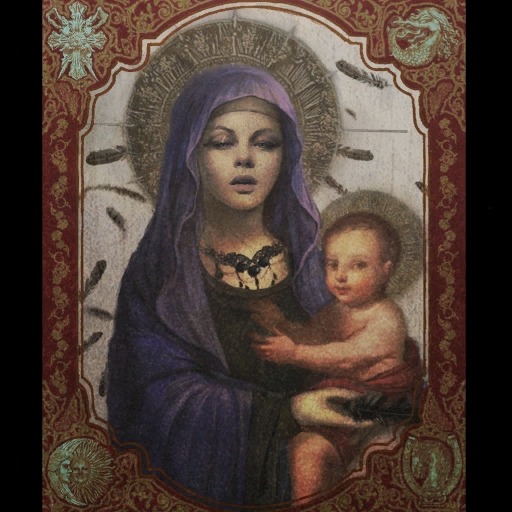

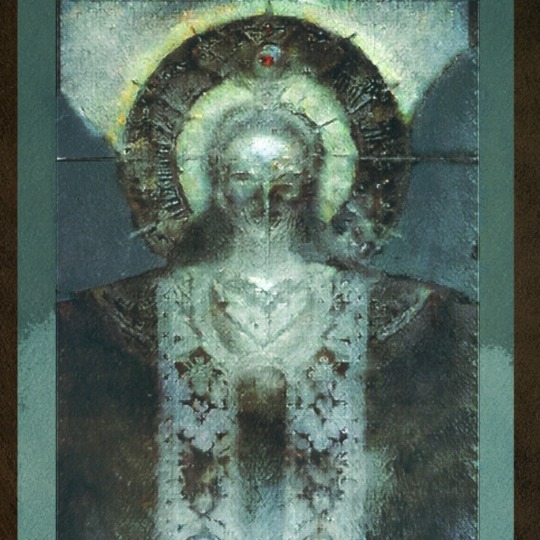
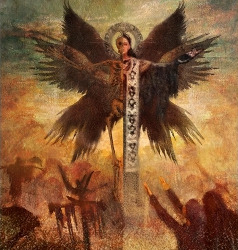

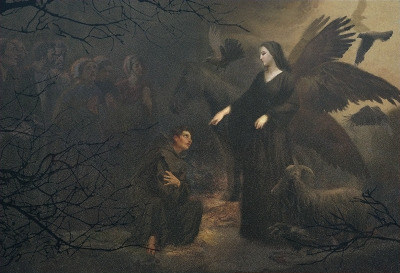
Cultic Iconography in Resident Evil Village
As the kind of nerd who loves all the creepy artwork you can find decorating Miranda-shrines around the village (like, just check out that one of the half-skeletal Miranda hovering in the graveyard and just tell me that isn't metal AF), I was on the lookout for the original image assets while poking through the game files. I'm hardly an expert on Catholic or Orthodox iconography (plenty of which is creepy enough just to begin with), but I adore how you can see all those elements being twisted and appropriated by Miranda's cult. You'll find these six pictures plastered all over the village in various combinations.
So you can imagine how thrilled I was to find a whole extra batch of unused artwork in the same set!





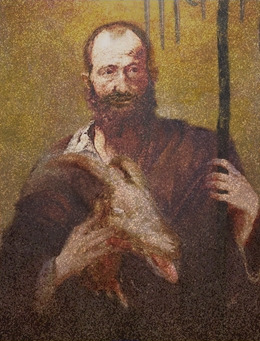
Lest you doubt these were all meant to go together, they all hail from the one big compilation file ‒ I've just cropped them out separately for ease of viewing. For all I know, maybe some of these were used somewhere in the game and I just never caught it (and if you have spotted any, please let me know!)
But taken at face value, our unused images consist of one picture of the megamycete, a 10-winged-madonna figure (why limit yourself to just 6?), a side profile of Miranda herself (possibly excluded because it shows off a little too much of her real face?), two images of dead crows, and (strangest of all) a man holding a goat head.
That last pic especially stands out ‒ and not just because I could (and, indeed, now have) legit write you a whole essay on just the significance of the goat's head motif as a protective symbol in the village (seriously, it's everywhere from the Goats of Warding to the symbol on the shield of the Maiden of War statue), so I'm going to be all over any new example. But who the hell is that guy carrying it? No other image centers anyone but Miranda herself as an object of worship. This looks more like someone's taken a generic pic of the likes of St Francis of Assisi hanging out with some animals (it's a theme, you can look it up), then just cut the poor animal off at the neck for added creep factor.
So do we take it that this guy was, at some point, meant to be another key figure in Miranda's cult? Or was generic-saint-with-animal-plus-extra-squick all they were really going for? Was it drawn before the writers made Miranda the cult leader? Or could this even have been intended (as the goats themselves seem to be) as some in-universe, pre-Miranda relic of an earlier era?
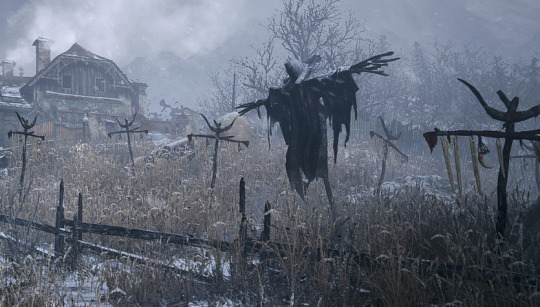
Also interesting: he appears to be holding one of those ornate staves you can also see in the fire and skeletal images of Miranda above (and can also find in the field near Luisa's early in the game, before they're all replaced by charred, semi-crucified corpses). Did that symbol predate Miranda too? Fascinating, either way.
Those two crow pictures may be even more intriguing still. I'm sure we all remember that spooky batch of dead and/or hanging crows Ethan discovers at the start of his descent into the village, but thereafter nothing like that is ever seen again. Given that Miranda herself is so closely associated with crows, it's reasonable to wonder if this very-literal murder-of-crows was in fact some act of heresy by an unbeliever, deliberately hidden out in the woods.
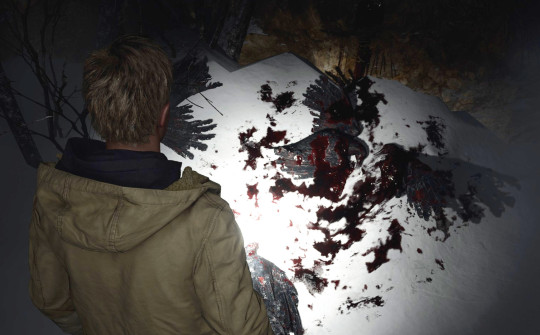
But if images of dead crows ‒ including one hung in the very same position ‒ were at some point intended to appear alongside other images of Miranda-veneration, then presumably veneration was always the intent for those dead crows out in the woods. Suffering is, of course, a key part of the stories of so many saints. And perhaps crows are sacred only in the same way that the goats are: ideal candidates for ritual sacrifice.
Much as I love all the concept art you can already unlock with the game, I'd pay good money for a proper artbook going into all this kind of design work. There's clearly so much more that went into the concept art stages of this game that I'd love to hear more about.
And while we're at it, here's a nice big version of the standard winged-fetus symbol too:
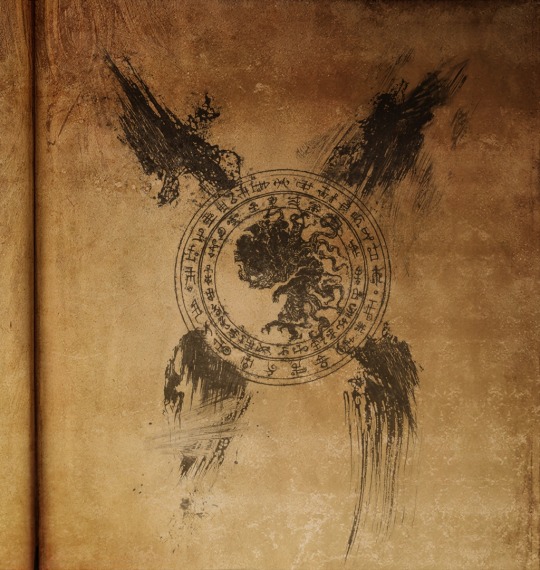
179 notes
·
View notes




